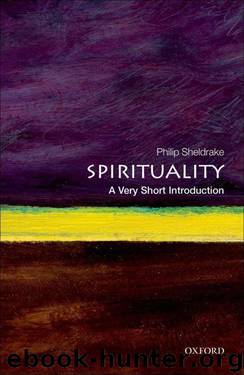Spirituality: A Very Short Introduction (Very Short Introductions) by Sheldrake Philip

Author:Sheldrake, Philip [Sheldrake, Philip]
Language: eng
Format: mobi, epub
Publisher: Oxford University Press
Published: 2012-11-28T16:00:00+00:00
Spirituality and transformation
Alongside general life development, another central concern of spirituality is the need for ‘transformation’. For example, in Christian spirituality ‘conversion’ from the tendency to sin or to be self-absorbed is a key idea. Whatever words we adopt, every classic spiritual tradition offers some form of wisdom regarding transformation from the humanly ‘inauthentic’ to the ‘authentic’. To this end, such traditions address five broad questions. First, what needs to be transformed in human existence and why? Second, what factors stand in the way of our journey of transformation? Third, where does transformation best take place, in the midst of everyday life or in intentional lifestyles? Fourth, how does transformation take place and what spiritual practices assist it? Finally, what is the final purpose of transformation and what are we to be transformed into? These questions relate closely to the notion that spirituality embodies a vision of the human spirit and of what will bring it to fulfilment.
One of the most widespread spiritual images is that of pilgrimage or a journey with various stages. For example, in Hinduism there is the concept of four asramas, or orders of life: studentship, the householder stage, the stage of being a ‘forest dweller’ (hermit), and, finally, sannyasa—a life of material renunciation dedicated wholly to the divine. In Christian literature the theme of life as a pilgrimage has been a rich one. It appears, for example, in Augustine’s City of God in the 5th century and in John Bunyan’s Pilgrim’s Progress in the 17th century. The metaphor of a journey expresses the radically dynamic nature of the spiritual life. During the Western Middle Ages, the conception of the inner spiritual journey developed into a ‘threefold path’ called the purgative, illuminative, and unitive ‘ways’. These are associated with, first, purification from spiritual limitations, then growth in contemplative insight, and, finally, an intense connection with the sacred. While these ways were traditionally described as consecutive stages, they are really interweaving dimensions of transformation in which no stage is ever wholly complete.
Download
Spirituality: A Very Short Introduction (Very Short Introductions) by Sheldrake Philip.epub
This site does not store any files on its server. We only index and link to content provided by other sites. Please contact the content providers to delete copyright contents if any and email us, we'll remove relevant links or contents immediately.
The remains of the day by Kazuo Ishiguro(8828)
Tools of Titans by Timothy Ferriss(8219)
Giovanni's Room by James Baldwin(7195)
The Black Swan by Nassim Nicholas Taleb(7014)
Inner Engineering: A Yogi's Guide to Joy by Sadhguru(6728)
The Way of Zen by Alan W. Watts(6507)
Asking the Right Questions: A Guide to Critical Thinking by M. Neil Browne & Stuart M. Keeley(5649)
The Power of Now: A Guide to Spiritual Enlightenment by Eckhart Tolle(5607)
The Six Wives Of Henry VIII (WOMEN IN HISTORY) by Fraser Antonia(5397)
Astrophysics for People in a Hurry by Neil DeGrasse Tyson(5134)
Housekeeping by Marilynne Robinson(4348)
12 Rules for Life by Jordan B. Peterson(4250)
Double Down (Diary of a Wimpy Kid Book 11) by Jeff Kinney(4208)
The Ethical Slut by Janet W. Hardy(4175)
Skin in the Game by Nassim Nicholas Taleb(4164)
Ikigai by Héctor García & Francesc Miralles(4125)
The Art of Happiness by The Dalai Lama(4063)
Skin in the Game: Hidden Asymmetries in Daily Life by Nassim Nicholas Taleb(3932)
Walking by Henry David Thoreau(3894)
